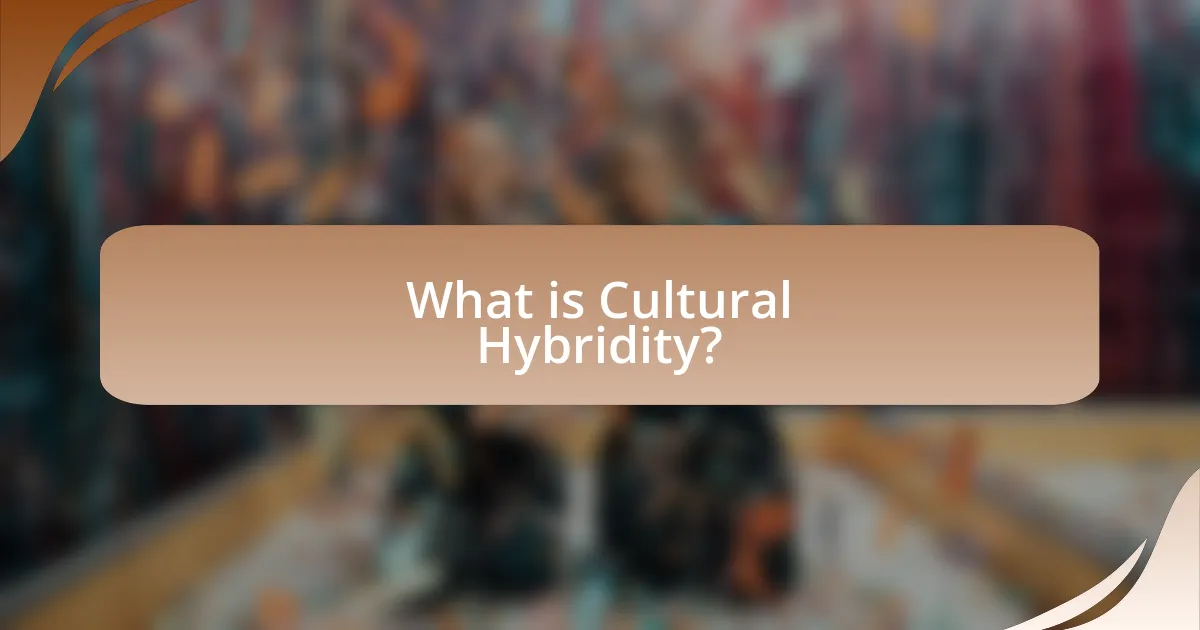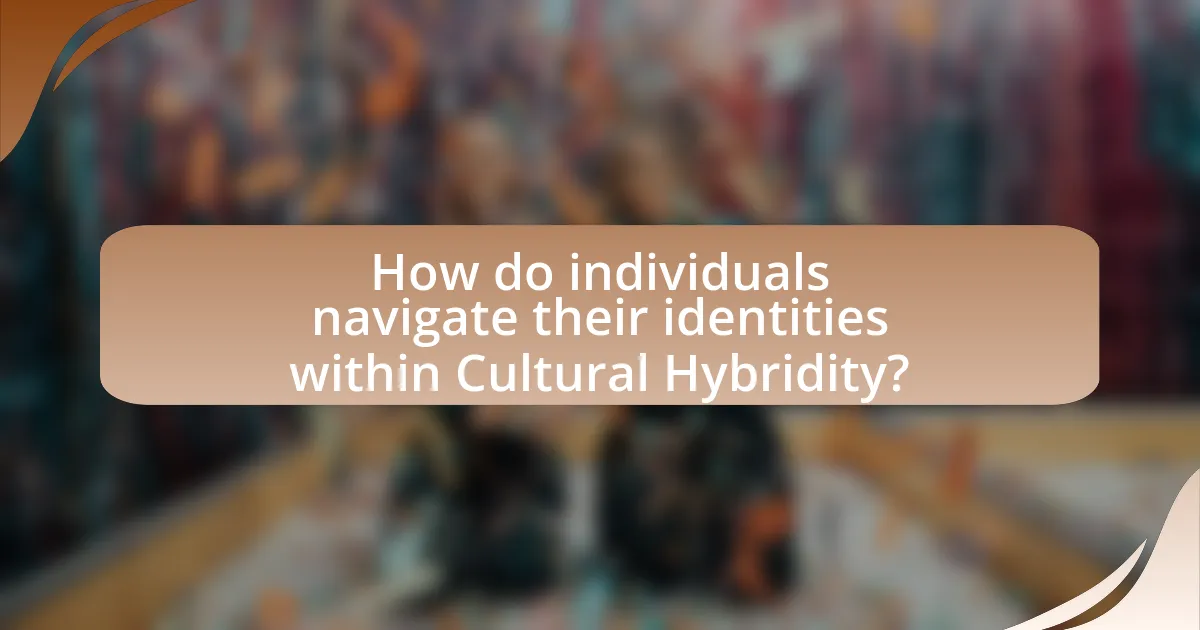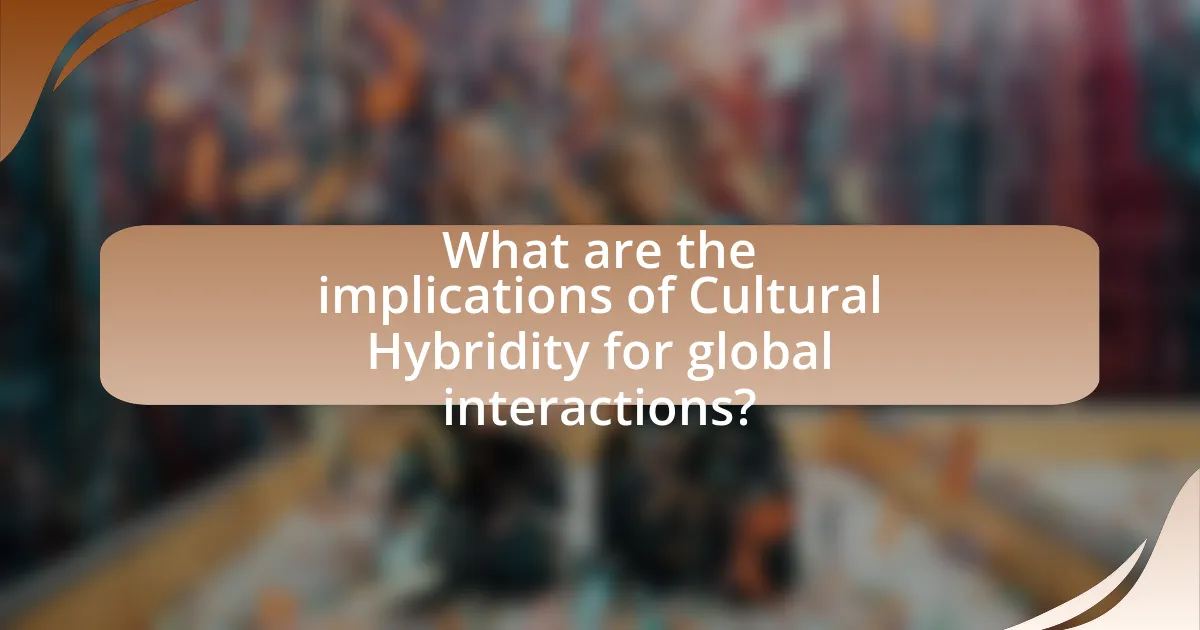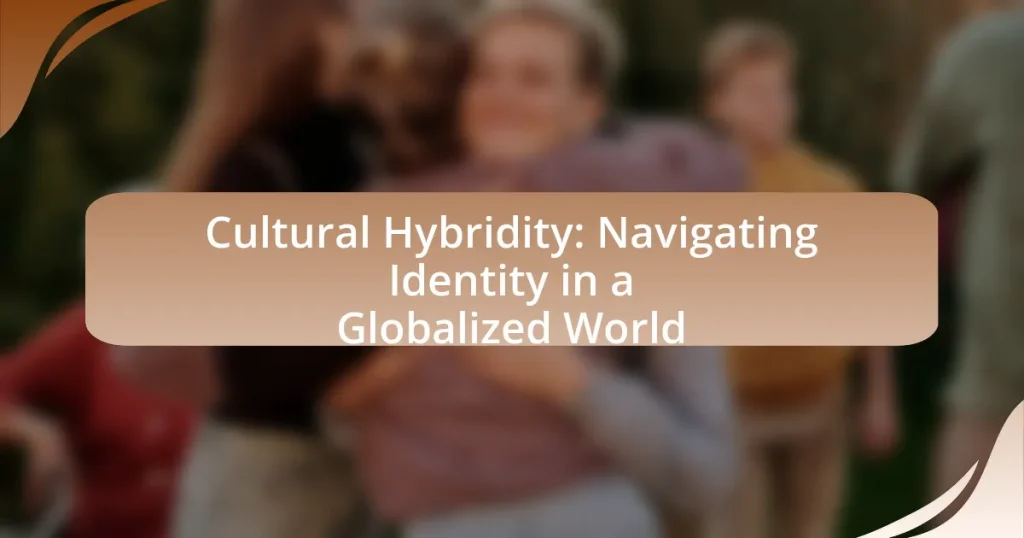Cultural hybridity refers to the blending of elements from different cultures to create new forms of cultural expression, particularly in the context of globalization. This article explores how cultural hybridity manifests in various societies, highlighting its impact on identity formation, social interactions, and community dynamics. Key characteristics include the fusion of traditions, languages, and practices, which can enhance social cohesion while also presenting challenges such as identity confusion and cultural dissonance. The article further examines the implications of cultural hybridity for global interactions, economic impacts, and the risks of cultural appropriation and identity dilution, providing insights into best practices for individuals to embrace their hybrid identities.

What is Cultural Hybridity?
Cultural hybridity is the blending of elements from different cultures to create new, hybrid forms of cultural expression. This phenomenon often occurs in contexts of globalization, where diverse cultural influences interact and merge, leading to the emergence of unique identities and practices. For instance, the fusion of musical styles, such as reggae and hip-hop, exemplifies cultural hybridity, showcasing how different cultural backgrounds can combine to produce innovative art forms.
How does Cultural Hybridity manifest in different societies?
Cultural hybridity manifests in different societies through the blending of diverse cultural elements, resulting in unique identities and practices. For instance, in urban centers like New York City, cultural hybridity is evident in the fusion of cuisines, music genres, and languages, where influences from various immigrant communities create a multicultural landscape. Similarly, in Brazil, the combination of Indigenous, African, and European traditions has led to distinctive cultural expressions such as samba and capoeira, showcasing how hybrid identities emerge from historical interactions. These examples illustrate that cultural hybridity is not merely a theoretical concept but a tangible reality shaped by migration, globalization, and social interactions, leading to dynamic cultural landscapes across the globe.
What are the key characteristics of Cultural Hybridity?
Cultural hybridity is characterized by the blending of diverse cultural elements, resulting in new forms of expression and identity. This phenomenon often manifests through the fusion of traditions, languages, and practices from different cultures, creating a dynamic and fluid cultural landscape. For instance, in urban centers, individuals may adopt fashion styles that combine influences from various cultures, reflecting a hybrid identity. Additionally, cultural hybridity can lead to the emergence of new art forms, music genres, and culinary practices that draw from multiple cultural backgrounds, illustrating the interconnectedness of global societies. This blending not only enriches cultural experiences but also challenges traditional notions of cultural purity, highlighting the complexity of identity in a globalized world.
How does Cultural Hybridity influence social interactions?
Cultural hybridity influences social interactions by fostering diverse communication styles and behaviors that blend elements from multiple cultures. This blending allows individuals to navigate social contexts more fluidly, adapting their interactions based on cultural cues from different backgrounds. For instance, research by Homi K. Bhabha highlights how cultural hybridity creates a “third space” where new identities and social practices emerge, facilitating dialogue and understanding among diverse groups. This dynamic can lead to enriched social networks and collaborative relationships, as individuals draw on a wider range of cultural references and practices in their interactions.
Why is Cultural Hybridity important in a globalized world?
Cultural hybridity is important in a globalized world because it fosters intercultural dialogue and understanding, enabling diverse communities to coexist and collaborate. This blending of cultures allows for the exchange of ideas, practices, and values, which can lead to innovation and social cohesion. For instance, research by Néstor García Canclini highlights how cultural hybridity can enhance social integration by creating new identities that reflect multiple cultural influences, thus promoting tolerance and reducing conflict among different cultural groups.
What role does Cultural Hybridity play in identity formation?
Cultural hybridity plays a significant role in identity formation by allowing individuals to blend elements from multiple cultures, thereby creating a unique personal identity. This blending facilitates the negotiation of cultural differences and the construction of a multifaceted self-concept, which is particularly relevant in a globalized world where diverse cultural influences are prevalent. Research indicates that individuals who engage with cultural hybridity often experience increased adaptability and resilience, as they draw from various cultural resources to navigate their social environments. For instance, studies have shown that bicultural individuals can leverage their dual cultural identities to enhance social interactions and problem-solving abilities, demonstrating the practical benefits of cultural hybridity in shaping identity.
How does Cultural Hybridity affect cultural preservation?
Cultural hybridity affects cultural preservation by creating a dynamic interplay between the integration of diverse cultural elements and the maintenance of traditional practices. This blending can lead to the revitalization of cultural expressions, as seen in the emergence of new art forms and practices that draw from multiple cultural backgrounds, thereby fostering innovation while simultaneously risking the dilution of original cultural identities. For instance, the fusion of indigenous music with contemporary genres has resulted in a resurgence of interest in traditional instruments and styles, illustrating how hybrid forms can enhance cultural visibility and relevance. However, this process can also challenge the authenticity of cultural practices, as the original meanings may become obscured or altered in the hybridization process.

How do individuals navigate their identities within Cultural Hybridity?
Individuals navigate their identities within cultural hybridity by integrating elements from multiple cultural backgrounds to form a unique self-concept. This process often involves selective appropriation of cultural practices, values, and symbols that resonate personally, allowing individuals to create a hybrid identity that reflects their diverse experiences. Research indicates that individuals in multicultural environments frequently engage in identity negotiation, balancing their heritage with the influences of the dominant culture, which can lead to a dynamic and fluid sense of self. For instance, studies show that second-generation immigrants often blend their parents’ cultural traditions with those of their new country, resulting in a multifaceted identity that embodies aspects of both cultures.
What challenges do individuals face in a hybrid cultural landscape?
Individuals in a hybrid cultural landscape face challenges such as identity confusion, cultural dissonance, and social integration issues. Identity confusion arises when individuals struggle to reconcile multiple cultural influences, leading to a fragmented sense of self. Cultural dissonance occurs when conflicting cultural norms and values create tension, making it difficult for individuals to navigate social interactions. Social integration issues manifest as difficulties in forming connections with others who may not share the same hybrid cultural background, potentially resulting in feelings of isolation. These challenges are supported by research indicating that individuals in multicultural environments often report higher levels of stress related to identity and belonging (Berry, 1997, “Immigration, Acculturation, and Adaptation”).
How do personal experiences shape one’s hybrid identity?
Personal experiences significantly shape one’s hybrid identity by influencing how individuals integrate diverse cultural elements into their self-concept. These experiences, such as migration, intercultural relationships, and exposure to multiple languages, create a unique blend of cultural influences that contribute to a person’s identity. For instance, research by Homi K. Bhabha in “The Location of Culture” emphasizes that hybrid identities emerge from the negotiation of cultural differences, highlighting how personal encounters with various cultures lead to a redefinition of self. This process is further supported by studies showing that individuals who navigate multiple cultural contexts often develop a more nuanced understanding of identity, allowing them to embody and express a hybrid identity that reflects their diverse experiences.
What strategies do individuals use to reconcile multiple cultural influences?
Individuals reconcile multiple cultural influences through strategies such as cultural integration, selective adaptation, and identity negotiation. Cultural integration involves blending elements from different cultures to create a cohesive identity, allowing individuals to draw from diverse traditions and practices. Selective adaptation refers to the process of choosing specific cultural traits that resonate personally, enabling individuals to maintain a sense of belonging while honoring their multifaceted backgrounds. Identity negotiation occurs when individuals actively engage in discussions about their cultural identities, facilitating understanding and acceptance among different cultural groups. These strategies are supported by research indicating that individuals who navigate multiple cultural influences often experience enhanced creativity and problem-solving abilities, as they synthesize diverse perspectives.
How does Cultural Hybridity impact community dynamics?
Cultural hybridity significantly impacts community dynamics by fostering increased interaction and collaboration among diverse cultural groups. This interaction leads to the blending of traditions, languages, and practices, which can enhance social cohesion and mutual understanding. For instance, in multicultural urban areas, cultural hybridity often results in the creation of hybrid cultural festivals that celebrate various heritages, promoting inclusivity and community engagement. Research indicates that communities characterized by cultural hybridity tend to exhibit higher levels of creativity and innovation, as diverse perspectives contribute to problem-solving and cultural production. This dynamic can be observed in cities like Toronto, where the amalgamation of cultures has led to a vibrant arts scene and economic growth, demonstrating the positive effects of cultural hybridity on community dynamics.
What are the effects of Cultural Hybridity on social cohesion?
Cultural hybridity positively affects social cohesion by fostering inclusivity and mutual understanding among diverse groups. This blending of cultural elements encourages individuals to appreciate different perspectives, which can lead to stronger community bonds. Research indicates that societies characterized by cultural hybridity often experience lower levels of conflict and higher levels of cooperation, as seen in multicultural cities like Toronto, where diverse cultural expressions contribute to social integration and community engagement.
How do communities adapt to Cultural Hybridity?
Communities adapt to cultural hybridity by integrating diverse cultural elements into their social practices and identities. This adaptation often involves the blending of traditions, languages, and customs, allowing communities to create a unique cultural identity that reflects both local and global influences. For instance, in urban areas with high immigrant populations, cultural festivals often showcase a mix of traditional and contemporary practices, fostering social cohesion and mutual understanding among different cultural groups. Research indicates that such integration can enhance community resilience and innovation, as seen in cities like Toronto, where multicultural policies have led to vibrant cultural exchanges and economic growth.

What are the implications of Cultural Hybridity for global interactions?
Cultural hybridity significantly influences global interactions by fostering cross-cultural exchanges and creating new identities. This blending of cultures leads to increased collaboration and understanding among diverse groups, as seen in multicultural societies where individuals share and adapt various cultural practices. For instance, the rise of global cities like New York and London showcases how cultural hybridity enhances economic ties and social networks, facilitating international trade and cooperation. Additionally, research indicates that cultural hybridity can mitigate conflicts by promoting tolerance and acceptance, as individuals learn to appreciate different perspectives. Thus, cultural hybridity plays a crucial role in shaping a more interconnected and harmonious global landscape.
How does Cultural Hybridity influence globalization?
Cultural hybridity significantly influences globalization by facilitating the blending of diverse cultural elements, which enhances cross-cultural interactions and exchanges. This blending allows for the creation of new cultural forms that reflect a combination of local and global influences, thereby fostering a more interconnected world. For instance, the rise of global cuisine, which incorporates ingredients and cooking techniques from various cultures, exemplifies how cultural hybridity can lead to the globalization of food practices. Additionally, cultural hybridity promotes tolerance and understanding among different cultural groups, as seen in multicultural societies where diverse traditions coexist and enrich the social fabric. This dynamic interplay between local and global cultures ultimately drives globalization forward by encouraging innovation and collaboration across borders.
What are the economic impacts of Cultural Hybridity?
Cultural hybridity has significant economic impacts, primarily by fostering innovation and enhancing market diversity. This blending of cultural elements leads to the creation of new products and services that cater to diverse consumer preferences, thereby expanding market reach. For instance, the fusion of culinary traditions can result in unique dining experiences that attract a broader customer base, as seen in cities with diverse populations where hybrid cuisines thrive. Additionally, cultural hybridity can stimulate tourism, as travelers seek authentic experiences that reflect a blend of cultures, contributing to local economies. Research indicates that regions embracing cultural diversity often experience higher economic growth rates, as evidenced by studies showing that cities with vibrant multicultural environments tend to attract more investments and talent.
How does Cultural Hybridity affect international relations?
Cultural hybridity affects international relations by fostering greater understanding and collaboration among diverse nations. This phenomenon encourages the blending of cultural practices, values, and perspectives, which can lead to more effective diplomacy and conflict resolution. For instance, the rise of multicultural societies has prompted countries to engage in dialogue that respects and incorporates various cultural viewpoints, thereby reducing tensions and promoting cooperation. Research indicates that nations with higher levels of cultural exchange and hybrid identities often experience improved bilateral relations, as seen in the collaborative efforts of countries in the European Union, where cultural diversity is embraced as a strength rather than a barrier.
What are the potential drawbacks of Cultural Hybridity?
Cultural hybridity can lead to the dilution of distinct cultural identities. This occurs when dominant cultures overshadow local traditions, resulting in a loss of cultural heritage and authenticity. For instance, in many urban areas, the prevalence of global brands can diminish local customs and practices, as seen in cities where traditional markets are replaced by international retail chains. Additionally, cultural hybridity may create tensions among communities, as individuals struggle to reconcile differing cultural values and practices, potentially leading to social fragmentation.
How can Cultural Hybridity lead to cultural appropriation?
Cultural hybridity can lead to cultural appropriation when elements from one culture are adopted by another without understanding or respecting their original context. This often occurs in globalized societies where dominant cultures may borrow aspects from marginalized cultures, resulting in a superficial representation that strips away meaning. For instance, the commercialization of traditional Indigenous attire in fashion shows exemplifies how cultural hybridity can morph into appropriation, as it commodifies sacred symbols without acknowledging their significance. This dynamic highlights the power imbalances inherent in cultural exchanges, where the dominant culture benefits while the original culture is disrespected or misrepresented.
What are the risks of identity dilution in Cultural Hybridity?
The risks of identity dilution in cultural hybridity include the potential loss of distinct cultural identities and the homogenization of cultural practices. When individuals or groups adopt elements from multiple cultures, they may inadvertently weaken their original cultural identity, leading to a blending that lacks the depth and richness of the individual cultures involved. This phenomenon can result in a superficial understanding of cultural elements, where the unique traditions, languages, and values of a culture are overshadowed by dominant global influences. Research indicates that such dilution can lead to cultural dislocation, where individuals feel disconnected from their heritage, as seen in various immigrant communities that struggle to maintain their cultural practices in the face of assimilation pressures.
What best practices can individuals adopt to embrace Cultural Hybridity?
Individuals can embrace Cultural Hybridity by actively engaging in cross-cultural experiences and fostering open-mindedness. Engaging in diverse cultural practices, such as participating in cultural festivals or learning new languages, allows individuals to appreciate and understand different perspectives. Open-mindedness encourages individuals to challenge their own cultural assumptions and embrace new ideas, which is essential in a globalized world where cultural interactions are frequent. Research indicates that exposure to multiple cultures enhances creativity and problem-solving skills, as seen in studies by the American Psychological Association, which highlight the cognitive benefits of cultural diversity.
How can individuals celebrate their hybrid identities?
Individuals can celebrate their hybrid identities by actively engaging in cultural practices that reflect their diverse backgrounds. This can include participating in traditional festivals, cooking and sharing dishes from different cultures, and learning languages that represent their heritage. Research shows that individuals who embrace their hybrid identities often report higher levels of self-esteem and belonging, as highlighted in a study by Phinney and Ong (2007) in the Journal of Adolescence, which found that multicultural individuals who celebrate their diverse backgrounds experience positive psychological outcomes. By creating spaces for dialogue and expression, such as community events or art projects, individuals can further honor their multifaceted identities and foster connections with others who share similar experiences.
What resources are available for navigating Cultural Hybridity effectively?
Resources available for navigating Cultural Hybridity effectively include academic literature, community organizations, and online platforms. Academic literature, such as “Cultural Hybridity” by Peter Burke, provides theoretical frameworks and case studies that illustrate the complexities of cultural blending. Community organizations often offer workshops and events that promote intercultural dialogue, helping individuals understand and appreciate diverse cultural perspectives. Online platforms, like forums and social media groups, facilitate discussions and share personal experiences related to cultural hybridity, fostering a sense of community among individuals navigating these identities. These resources collectively support individuals in understanding and embracing their multifaceted cultural identities in a globalized world.










